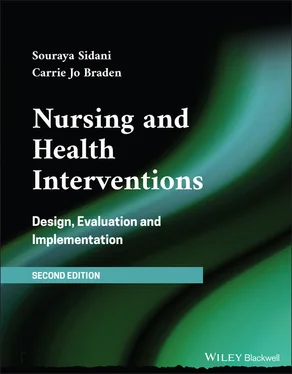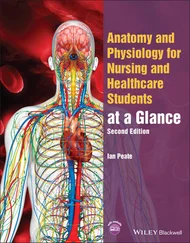All types of literature review are useful for understanding the health problem. The mixed‐method reviews are most promising in generating a comprehensive list of factors contributing to the problem, delineating direct and indirect relationships that are context‐dependent, and providing explanation of why and how the determinants contribute to the health problem.
The process for conducting literature reviews is systematic. It has been extensively described in different sources (e.g. Heyvaert et al., 2016) as comprised of several steps. The steps are briefly reviewed with a particular emphasis on understanding the health problem.
1 Clarifying the health problem: This first step involves delineating the nature of the health problem and specifying the context (i.e. characteristics of the client population and context) of interest. This step is important for specifying the key words to be used in searching the literature and the criteria for selecting literature sources. The goal is to enhance relevance of the literature to the problem and context of interest.
2 Specifying the key words: The key words are the terms used to refer to the health problem. They include the specific words (e.g. insomnia) and its synonyms (e.g. sleep problem, disorder, difficulty) frequently appearing in the scientific literature and mentioned in lay conversation or documents. Consultation with librarians is very helpful in finalizing the list of key words. The key words are used independently or in combination with other key words representing the target client population (e.g. older adults), context (e.g. primary care), and determinants of the problem (e.g. stress) if the determinants are known (e.g. derived from pertinent middle range theories); alternatively, the terms “factors,” “determinants,” “causes,” “predictors,” or similar ones are used in the initial search; and additional terms reflecting the specific factors identified through the review of the initial literature sources are used to refocus the search.
3 Conducting the search: The search for literature relevant to the experience and determinants of the health problem is carried out using multiple bibliographic databases pertaining to health literature in general or to specific health‐related disciplines (e.g. CINAHL, MEDLINE, PSYCHINFO), for comprehensiveness. The search may yield a large number of studies whose abstracts should be reviewed to determine their relevance. Setting reasonable limits to the search (e.g. language of publication and time period) enhances the relevance of the literature to the most recent conceptualization of the problem; further, the limits may render the review more focused and manageable.
4 Specifying the selection criteria: The criteria ensure the relevance of the literature sources to be selected. As mentioned previously, theoretical or conceptual and empirical sources can be included in the review if they address any aspect of the health problem (e.g. presentation of its conceptual definition, description of its indicators, and examination of its determinants). Quantitative and qualitative studies utilizing a range of research designs are sought, regardless of their quality. Quality is defined in terms of appropriately preventing or addressing biases that threaten validity of findings. Quality of the studies can be assessed with available tools and taken into account during the data analysis and synthesis steps.
5 Identifying and selecting sources: Having a list of the preset selection criteria and clearly specified definitions and indicators of these criteria facilitates the review of the sources. The selection is done in two stages. First, the abstract of the identified source is read and its content evaluated for relevance (i.e. meet all criteria). Second, copies of relevant sources are obtained for full review and, if considered to meet all preset criteria, are selected for inclusion in the literature review.
6 Extracting data: Selected sources are carefully reviewed to extract methodological (e.g. type of design, sample size, study quality) and substantive (e.g. conceptual and operational definitions of the problem and determinants investigated, target population, main findings related to the experience of the problem and its association with determinants). The data extracted are incorporated in a database in preparation for synthesis of quantitative, qualitative, or both types of findings.
7 Synthesizing data: Different strategies and techniques can be used to synthesize descriptive and correlational (representing the reported associations between determinants and the health problem) quantitative and qualitative findings, and to integrate quantitative and qualitative evidence (for detail, refer to Hong et al., 2017). The selection of a particular technique is informed by the type of data extracted, the number of studies included in the review, and the availability of resources needed to apply the technique.
TABLE 3.3 Narrative review of literature on determinants of insomnia.
| Category of predictors |
Results |
Sources |
| Predisposing factors |
Age: Older adults are prone to sleep disturbances (explanation: due to fragmented sleep or comorbid medical conditions) Gender: Women of all age groups have a higher prevalence of sleep problems than men |
Kao et al. (2008), López‐Torres Hidalgo et al. (2012), Paparrigopoulos et al. (2010), Rybarczyk et al. (2013), Singareddy et al. (2012), Zhang et al. (2012) |
| Precipitating factors |
Comorbidity: Having one or more chronic diseases (e.g. cancer, angina, multiple sclerosis); symptoms (e.g. pain); and sleep disorders (e.g. restless leg syndrome), increases the odds of experiencing sleep problems Psychological conditions: depressive symptomatology and perceived distress Social conditions: marital status, level of education and socioeconomic status |
Dragiotti et al. (2018), Fernandez‐Mendoza et al. (2012), Gindin et al. (2014), López‐Torres Hidalgo et al. (2012), Rybarczyk et al. (2013) Gindin et al. (2014), Isaia et al. (2011), Paparrigopoulos et al. (2010), Pillai et al. (2014), Vgontzas et al. (2012). Gellis et al. (2005), López‐Torres Hidalgo et al. (2012), Moscou‐Jackson et al. (2016) |
| Perpetuating factors |
Health behaviors: smoking, alcohol consumption, and limited engagement in physical activity |
Colagiuri et al. (2011), Endeshaw and Yoo (2010), Fernandez‐Mendoza et al. (2012), Paparrigopoulos et al. (2010) |
| Factors identified by persons with insomnia |
Worry, illness/discomfort Note: varied by age such as worry more frequently reported in early working life and illness by older adults |
Armstrong and Dregan (2014) |
The results of the literature review point to similarities or variations, across client populations, settings, and time occasions, in the experience of the health problem relative to its indicators and level of severity. They also identify the range of possible determinants and those most significant. They delineate the nature (direct or indirect); direction (positive or negative); and size (small, moderate, large) of the relationships among determinants and the health problem experience. The findings, particularly those synthesized from qualitative studies and from theoretical sources, provide probable explanations (why and how) of the relationships. Table 3.3illustrates the results of a narrative review of the literature on the determinants of insomnia.
The advantages of literature reviews rest on grounding the understanding of the health problem on actual data obtained by multiple researchers, from different client populations under different contexts, using different designs and methods. Results that are consistent across populations, contexts, and research methods enhance the accuracy of the conceptualization of the problem. Comprehensive lists of indicators and determinants of the problem are generated, reflecting different but complementary perspectives. These comprehensive lists reduce the likelihood of omitting a potentially significant indicator or determinant. The range of the severity level with which the problem is experienced by different client populations and in different contexts is identified. Factors contributing to different levels of problem severity may be revealed. Discrepancies in findings point to variability in the problem experience. This empirical knowledge of the health problem is useful in directing the development of interventions and in identifying the need for tailoring the intervention to the characteristics of different client populations and contexts.
Читать дальше












